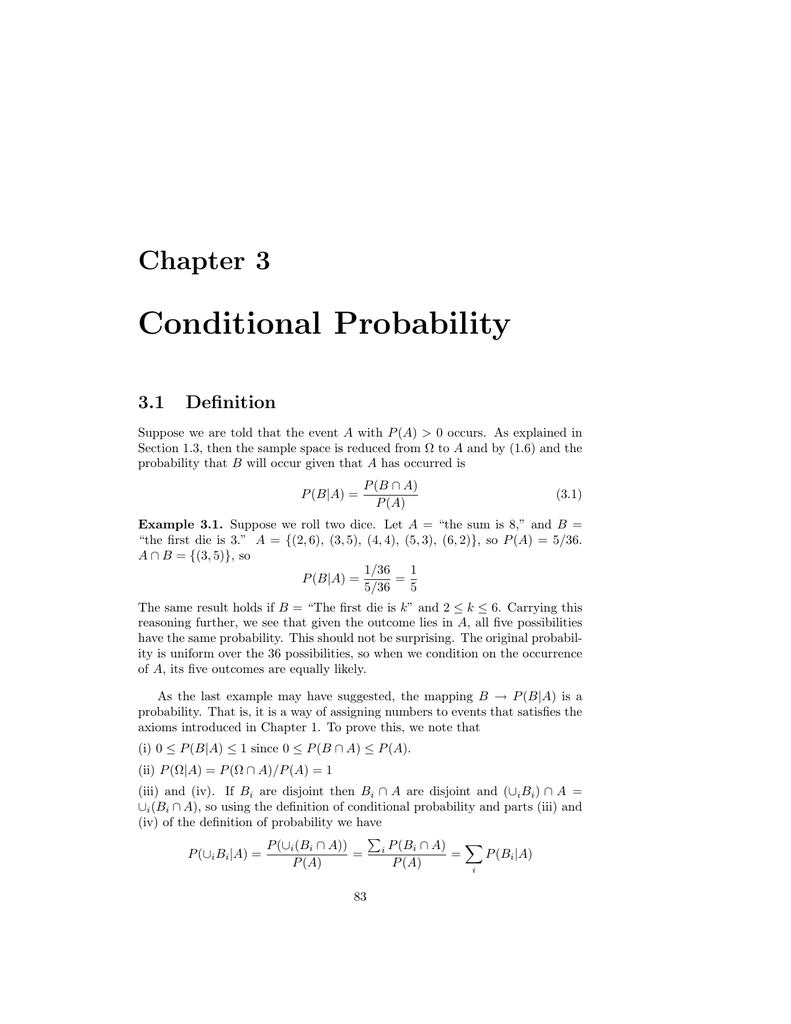Craps Conditional Probability
The dice game craps is played as follows: The player throws 2 dice, and if the sum is 7 or 11, he/she wins. If the sum is 2, 3, or 12, he/she loses. If the sum is anything else, then he/she continues throwing until that number appears again, or throws a 7, where the game ends in a loss. What I do know is that P(7) = 6 / 36, P(11) = 2 / 36.
In probability theory, the craps principle is a theorem about eventprobabilities under repeated iid trials. Let and denote two mutually exclusive events which might occur on a given trial. Then the probability that occurs before equals the conditional probability that occurs given that or occur on the next trial, which is
- (d) The probability that a bettor rolls an 8 on the first roll and then wins is given by P(8)P(8 7 or 8). Show that this probability is (5/36)(5/11). (e) Show that the total probability that a bettor wins in the game of craps is 0.49293.
- Conditional Probability IS a probability 10/12; Examples of using conditional probability 10/13; Monty Hall 10/14; Independence 10/14 and 10/16. Independence of more than two events 10/20; The Craps principle 10/16; Example of computation for craps 10/19. Joint Distributions 10/19, 10/20. Gambler's Ruin 10/21; Joint Probability Distribution for.

The events and need not be collectively exhaustive (if they are, the result is trivial).[1][2]
Proof[edit]
Let be the event that occurs before . Let be the event that neither nor occurs on a given trial. Since , and are mutually exclusive and collectively exhaustive for the first trial, we have
and . Since the trials are i.i.d., we have . Using and solving the displayed equation for gives the formula
- .
Application[edit]
If the trials are repetitions of a game between two players, and the events are
then the craps principle gives the respective conditional probabilities of each player winning a certain repetition, given that someone wins (i.e., given that a draw does not occur). In fact, the result is only affected by the relative marginal probabilities of winning and ; in particular, the probability of a draw is irrelevant.
Stopping[edit]
If the game is played repeatedly until someone wins, then the conditional probability above is the probability that the player wins the game. This is illustrated below for the original game of craps, using an alternative proof.
Craps example[edit]

If the game being played is craps, then this principle can greatly simplify the computation of the probability of winning in a certain scenario. Specifically, if the first roll is a 4, 5, 6, 8, 9, or 10, then the dice are repeatedly re-rolled until one of two events occurs:
Since and are mutually exclusive, the craps principle applies. For example, if the original roll was a 4, then the probability of winning is
Conditional Probability Examples
This avoids having to sum the infinite series corresponding to all the possible outcomes:
Mathematically, we can express the probability of rolling ties followed by rolling the point:
Craps Conditional Probability Definition

The summation becomes an infinite geometric series:
which agrees with the earlier result.
Craps Probabilities
References[edit]
- ^Susan Holmes (1998-12-07). 'The Craps principle 10/16'. statweb.stanford.edu. Retrieved 2016-03-17.
- ^Jennifer Ouellette (31 August 2010). The Calculus Diaries: How Math Can Help You Lose Weight, Win in Vegas, and Survive a Zombie Apocalypse. Penguin Publishing Group. pp. 50–. ISBN978-1-101-45903-4.
Notes[edit]
- Pitman, Jim (1993). Probability. Berlin: Springer-Verlag. p. 210. ISBN0-387-97974-3.